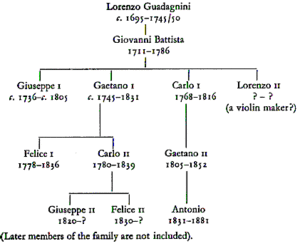Giovanni Battista Guadagnini facts for kids
Quick facts for kids
Giovanni Battista Guadagnini
|
|
|---|---|
| Born | 23 June 1711 Bilegno in Val Tidone, Italy
|
| Died | 18 September 1786 (aged 75) Turin, Italy
|
| Nationality | Italian |
| Known for | |
|
Notable work
|
|
| Style |
|
| Movement | Guadagnini school |
| Elected | Court luthier of Duchy of Parma |
| Patron(s) |
|
Giovanni Battista Guadagnini (often called G. B. Guadagnini) was born on June 23, 1711, and passed away on September 18, 1786. He was an amazing Italian luthier. A luthier is someone who makes or repairs string instruments like violins and guitars.
Many people think he was one of the best instrument makers ever. He is often ranked third, right after the famous Antonio Stradivari and Giuseppe Guarneri "del Gesù". The Guadagnini family was well-known for making beautiful violins, guitars, and mandolins.
Contents
Giovanni Battista Guadagnini's Life
Giovanni Battista Guadagnini was born in a small town called Bilegno in Italy. His life and work can be divided into four main parts. Each part is named after the city where he lived and worked. These cities were Piacenza, Milan, Parma, and Turin.
Early Years in Piacenza
We don't know much about Guadagnini's early life. He moved to the nearby city of Piacenza in 1738. His first violins started appearing around 1742.
It's not clear where he learned his skills. He likely trained with a local woodworker. However, there are no records of other instrument makers in Piacenza at that time.
Moving to Milan
In 1749, Guadagnini moved to Milan. He continued making instruments there. We don't know why he moved, but Milan was a much bigger city. It had a more active music scene, which might have offered more work.
Some of his instruments from this time have labels that suggest a connection to Cremona. Cremona was home to famous violin makers like Amati, Stradivari, and Guarneri. However, there is no proof that Guadagnini ever lived in Cremona.
Working in Parma
Guadagnini moved again in 1758, this time to Parma. He might have moved because his friend, Carlo Ferarri, got a job with the Duke's court there. In Parma, Guadagnini worked closely with the court. He even received a salary from them later on.
By 1771, the court's money was running low. Guadagnini asked if he could leave Parma.
Final Years in Turin
After Parma, he moved to Turin. In 1773, he started an important partnership with Count Cozio. The Count was a well-known violin collector.
Count Cozio bought most of Guadagnini's instruments during this time. He also gave Guadagnini most of his wood and other materials. Their business partnership ended in 1777, but they still worked together sometimes. The Count probably encouraged Guadagnini to make instruments more like Stradivari's. He even let Guadagnini study real Stradivari instruments.
Giovanni Battista Guadagnini passed away in Turin on September 18, 1786.
Guadagnini's Instruments
Guadagnini's work changed over his career. His instruments from each city look a bit different. This was because of the materials he could find and what local musicians wanted. His partnership with Count Cozio also influenced his style.
His instruments are usually not as perfectly smooth as those made by Amati or Stradivari. However, they are known for their excellent sound. He is seen as one of the last great historical instrument makers. He ranks just behind Stradivari and Guarneri.
Guadagnini's instruments are very valuable today. Some have sold for over $2,000,000 at auctions!
Famous Musicians and Guadagnini Instruments
Many famous musicians have played instruments made by Giovanni Battista Guadagnini. Here are a few examples:
- Julia Fischer plays a Guadagnini violin from 1742.
- David Garrett owned a Guadagnini violin from 1772. He bought it for $1 million.
- Jascha Heifetz played a Guadagnini violin from 1741.
- Viktoria Mullova plays a Guadagnini violin from 1750.
- Vanessa-Mae plays a Guadagnini violin from 1761, which she calls Gizmo.
- Natalie Clein plays the "Simpson" Guadagnini cello from 1777.
- Han-na Chang plays a Guadagnini cello made in Milan in 1757.
- The Australian String Quartet (ASQ) uses four matching Guadagnini instruments. These include a cello from around 1743, a violin from 1748–49, a viola from 1783, and another violin from 1784.
See also
 In Spanish: Giovanni Battista Guadagnini para niños
In Spanish: Giovanni Battista Guadagnini para niños


